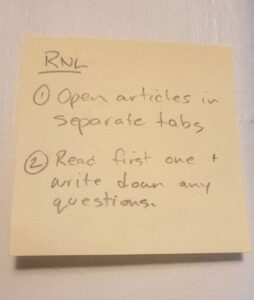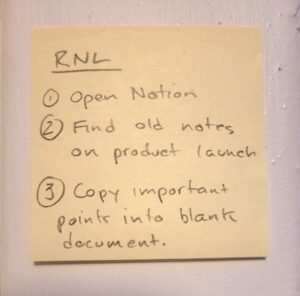The Right Now List

Some percentage of you are your own boss, or work from home, or otherwise have a dangerous level of flexibility around when you actually get to work.
Some of you also know you’re especially prone to procrastination, even on a good day.
If you’re both of these things, you know how deadly the combination can be. Severe procrastination isn’t just annoying or frustrating, it’s a tragic loss of life. You let days and weeks go by for no good reason and hate yourself for it.
After battling with this for several decades, I have no cures but many tools.
Here’s one that helps me a lot. How to Do Things readers already know this trick, but it deserves further unpacking in anyway, because it really works.
Whenever I’m anything less than completely enthusiastic about getting to work, which is almost always, I put a square yellow sticky note in the corner of my desk and write “RNL” at the top.
This stands for “Right Now List.” A Right Now List is a short list of the first two or three things I need to do right now — not eventually, but at the absolute beginning of the task I’m currently trying (or hoping) to do.
The key is that the items on the Right Now List are so tiny and easy that even a masterful procrastinator won’t talk himself out of doing them. Things like:
- Open Microsoft Word
- Find the document I was working on yesterday
- Scroll down to where I left off
These tasks are too easy to trigger the procrastinatory mind’s usual objections — that familiar, weaselly inner voice that goes, “So… uh… do I truly need to do this right now?” RNL tasks are such easy and immediate wins that it’s more tempting to do them than to make sheepish arguments to yourself about why you should do them later.
Even the most shrewd procrastinatory mind cannot believe its own arguments here: Is there any way I can double-click this icon tomorrow instead? Maybe I can get up a bit early, make some stiff black coffee, and then scroll down.
So you start. You do these trivial first actions, because they’re so stupidly easy, and then you’re working on the task. You’re inside the compound. You’re no longer trying to “get started.” Most of the resistance is gone, it’s clear enough what to do next, and it feels good to continue.
All the Right Now List does is articulate the beginning of the task at hand into more granular steps than we typically think we need, right down to two-second movements like “Take the ledger from the shelf. Open it to the last complete month.”
Normally, tasks are defined on a “to-do-list” level: “Get ledger up to date,” “Figure out Valentine’s Day plans,” or “Get back to Fred.” Although these phrases seem clear enough to direct your efforts, tasks expressed on this level are still quite abstract, and invite abstract thinking and worry that mushrooms beyond the task itself, inhibiting you from starting. Such descriptors don’t indicate how or where to start, and they raise too many questions that seemingly need answers before you feel ready to properly deal with the task. Will Fred O.K. my proposal? Is he already mad at me? Do people still use PowerPoint for this kind of stuff or am I some kind of early-aughts dinosaur?
By that point, which might be only ten seconds after glancing at your to-do list, you’re already clicking over to a Substack you’ve been meaning to read.
The Right Now List circumvents this pattern. Instead of focusing on the whole task in the abstract, and inviting all of its baggage into your head, you focus only on what needs to happen right now, with enough granularity that nothing on the list is harder than trivially easy.
RNL tasks usually consist of assembling the necessary documents or tools and then looking over them. You make your little list of too-easy-to-fail tasks, begin knocking them off with ease, and suddenly you’re no longer skulking around outside the task’s gates, conferring with your procrastinatory demons.
Instead, you get yourself inside right away. Then, when the task’s inevitable challenges come, they don’t occur in the unbounded expanse of the imagination, while you’re still convincing yourself to get to work. They happen when you’re already working, you have your tools with you, and your inertia is that of action and not inaction.
You don’t have to think very hard about what should go on the Right Now List. They will be actions so obvious it seems absurd to write them down: finding the appropriate file, clearing a space on your desk, opening a blank document on your second monitor.
Indeed, most people would never write these steps down — and many of them struggle with procrastination. Writing them down despite their triviality reminds you that you can start virtually any task with no pain or confusion.
If starting is half the battle, and you can make that half trivially easy, the other half seems perfectly doable.
***
Need help getting things done?
The big productivity books are written by people who don’t especially struggle with productivity.
The rest of us find other ways. I shared mine in this post.
Photo by Keith Hardy


